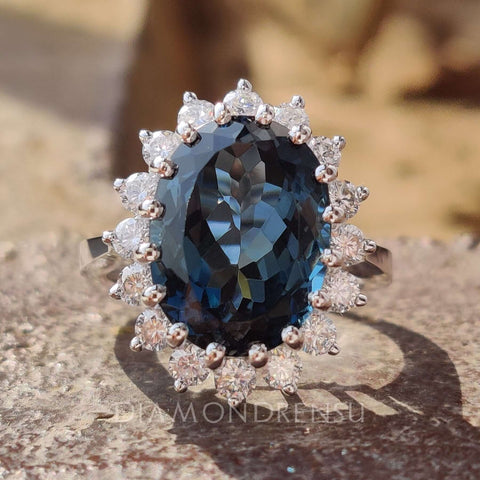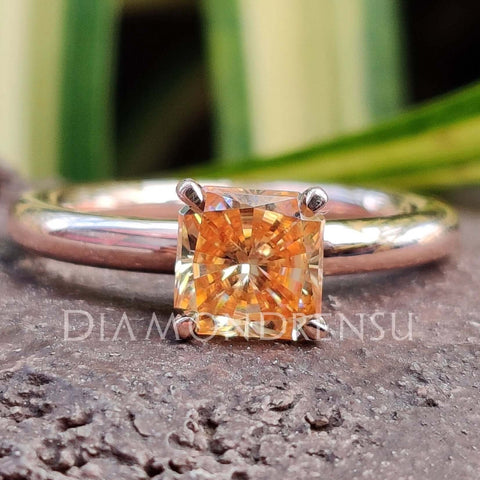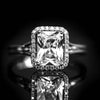
Is Moissanite Harder than a Diamond? Exploring Gemstone Durability
Moissanite, a gemstone first discovered in a meteor crater, has gained popularity in recent years as an alternative to diamonds. Its striking similarity in appearance and brilliance often leaves people wondering how these two stones compare when it comes to hardness. In this article, we will explore the properties of both moissanite and diamond, and determine which gemstone is harder.
Hardness is an important factor when considering gemstones for jewelry, as it affects a stone's durability and resistance to scratches and chips. The Mohs scale of mineral hardness, which ranges from 1 to 10, is commonly used to measure and compare the hardness of different gemstones. Diamonds are known as the hardest substance on Earth, with a rating of 10 on the Mohs scale. Moissanite, on the other hand, has a slightly lower hardness rating of 9.25, making it one of the hardest materials known to man, but not quite as hard as a diamond.
Though moissanite may not be as hard as a diamond, its toughness and lack of cleavage make it an excellent choice for jewelry and daily wear. In fact, due to its resilient nature, moissanite is often considered to be more resistant to breakage than diamonds. This, combined with its affordability and ethically sourced nature, makes moissanite a desirable gemstone for many consumers, even though it falls just short in terms of hardness when compared to a diamond.
Understanding Moissanite and Diamond
Moissanite is a gemstone known for its striking similarity to diamond. It is made of silicon carbide, a compound formed by silicon and carbon atoms, whereas diamond is a naturally occurring form of carbon. Moissanite was first discovered in a meteor crater, making it a very rare mineral. Today, most moissanite available on the market is lab-grown, making it a more accessible and affordable option compared to natural diamonds.
In terms of composition, both moissanite and diamond exhibit specific characteristics that make them desirable as gemstones. Moissanite is known for its impressive refractive index, making it more brilliant and fiery than a diamond. This quality is showcased in various cuts such as Portuguese cut and cushion divine moissanite rings. On the other hand, diamonds are known for their incredible hardness and durability, which contributes to their long-standing reputation as a symbol of eternal love.
When comparing moissanite vs. diamond, there are some subtle differences in appearance. For instance, princess cut moissanite and radiant cut moissanite rings may exhibit a slightly different fire (the dispersion of light) compared to their diamond counterparts. Additionally, rose cut moissanite stones may have a unique appearance due to the faceting style.
While diamonds are the traditional choice for engagement rings, moissanite engagement rings have become increasingly popular due to their affordability, ethical considerations, and similar appearance to diamonds. With various cuts and styles available, moissanite offers an appealing alternative for those looking for a beautiful, durable gemstone.
In summary, both moissanite and diamond are remarkable gemstones with distinct qualities and characteristics. As a lab-grown and more affordable option, moissanite provides an ethical and sustainable choice for those seeking a durable, brilliant, and dazzling gemstone.
Physical Properties and Durability

When comparing the hardness of moissanite and diamond, it is essential to understand their physical properties and durability. Both gemstones exhibit exceptional qualities, which contribute to their popularity in the jewelry industry.
Diamonds are known for their exceptional hardness, ranking as a 10 on the Mohs scale of mineral hardness. The hardness of a diamond is attributed to its strong chemical composition and crystalline structure. Diamonds are composed of carbon atoms held together by covalent bonds, which gives them the characteristic toughness and high pressure resistance. These attributes make diamonds suitable for various applications beyond jewelry, such as cutting tools and industrial abrasives.
On the other hand, moissanite is an impressive contender in the durability department. With a Mohs scale hardness of 9.25, it is tougher than diamond in terms of resistance to chipping and breaking. Moissanite is composed of silicon carbide, whose crystals are known for their heat resistance and stability. This gemstone is also an excellent choice for jewelry, offering impressive qualities at a lower cost.
| Property | Moissanite | Diamond |
|---|---|---|
| Hardness (Mohs Scale) | 9.25 | 10 |
| Brilliance & Fire | High dispersion and brilliance | Exceptional brilliance and fire |
| Color Range | Nearly colorless; may have slight yellow or gray hues | Colorless to near-colorless (graded D to Z) |
| Clarity | Typically eye-clean with minimal inclusions | Varies; can include inclusions or blemishes |
| Toughness | Less tough than diamond, making it more prone to chipping or breaking | High toughness; less likely to chip or break |
In terms of clarity, diamonds are graded based on their inclusions or internal flaws. The fewer inclusions, the higher the clarity and subsequent quality of the diamond. Moissanite is generally created in a laboratory setting, which allows for greater control over the final product's quality. As a result, moissanite often has fewer inclusions and can present a higher clarity compared to some diamonds.
Size also plays a role in determining the physical properties of these gemstones. As a general rule, larger diamonds and moissanites will have more visible inclusions and lower clarity, affecting their overall quality. However, due to the inherent properties of these minerals and advances in laboratory techniques, high-quality gems can be produced in various sizes.
In conclusion, both diamond and moissanite exhibit remarkable durability, clarity, and physical properties. While diamonds are renowned for their hardness, moissanite stands out for its toughness and heat resistance. Therefore, both gemstones offer unique benefits, and the final choice between them depends on personal preferences, budget, and intended use.
Optical Characteristics and Appearance

Moissanite is an impressive gemstone that boasts unique optical characteristics, making it a popular alternative to diamonds. Although moissanite possesses a refractive index higher than that of a diamond, it displays exceptional brilliance and sparkle. This characteristic, coupled with its near-colorless appearance, often leads to the misconception that it is optically identical to diamonds.
In terms of color, moissanite is available in a splendid variety of hues, including colorless, green, and cyan blue, catering to different styles and preferences. While colorless moissanite closely resembles a diamond, green and cyan blue moissanite stones offer a distinctive look, setting them apart from traditional diamond jewelry.
| Characteristic | Moissanite | Natural Diamond |
|---|---|---|
| Brilliance | High dispersion and brilliance | Exceptional brilliance and fire |
| Fire | Greater fire with colorful flashes of light | Displays remarkable fire with spectral color flashes |
| Color | Nearly colorless with possible slight yellow or gray hues | Colorless to near-colorless (graded D to Z) |
| Clarity | Typically eye-clean with minimal inclusions | Clarity varies; some diamonds may have inclusions or blemishes |
| Sparkle and Scintillation | Displays exceptional sparkle and scintillation | Natural diamonds exhibit remarkable sparkle and scintillation |
Moissanite displays a stunning dispersion, or fire, which refers to the splitting of light into its constituent colors. Its dispersion value is higher than that of a diamond, causing moissanite to exude an even more captivating sparkle. However, some may argue that this difference makes it easier to tell moissanite apart from diamond, as a keen eye may detect the heightened fire.
When it comes to the cut, moissanite stones can be found in over 51 different shapes, allowing for a vast array of designs and styles. Ranging from traditional round brilliant to contemporary cushion cuts, the expertly crafted facets of moissanite stones interact with light to produce their outstanding optical properties.
In summary, while moissanite is not harder than a diamond, it offers its own set of exceptional optical characteristics and a distinctive sparkle. With its wide range of colors, shapes, and brilliance, moissanite is a versatile and attractive choice for those seeking an alternative to traditional diamonds.
Comparing Value and Prices

When considering the value of moissanite and diamonds, it's important to take into account factors such as price, carat weight, and overall advantages and disadvantages of each stone. Moissanite is often viewed as a more budget-friendly alternative to diamonds due to its lower price per carat. This makes it a popular choice for those looking to stay within a certain budget while still obtaining a beautiful, durable stone.
Moissanite has some advantages over diamonds, one being its impressive sparkle. With more dispersion than a diamond, moissanite exhibits a higher level of fire, giving it an eye-catching brilliance. This feature can often make moissanite rings appear more expensive than they actually are, adding to their value.
The carat weight of a moissanite stone does not have the same impact on its price as it does for diamonds. In fact, the price difference between smaller and larger moissanite stones is often less significant than that of diamonds. This allows for individuals to choose larger, more impressive stones without breaking the bank.
However, one potential downside to moissanite is its resale value. Unlike diamonds, which tend to maintain or even increase in value over time, moissanite tends to have a lower resale value. Furthermore, moissanite is often marketed as a diamond simulant, which could impact its perceived value in certain circles.
That said, moissanite's affordability makes it an attractive option for various occasions, such as Mother's Day gifts or Valentine's Day presents. These budget-conscious options allow consumers to enjoy the beauty and durability of a gemstone without the hefty price tag of a diamond.
In conclusion, when comparing the value and prices of moissanite and diamonds, consider factors such as budget, carat weight, and the intended use of the stone. With a clear understanding of the advantages and disadvantages of each option, individuals can make informed decisions and choose the perfect gemstone for their needs.
Ethics and Sustainability

The demand for ethical and sustainable gemstones has grown in recent years, as consumers have become more conscious of the environmental and humanitarian impact of diamond mining. Moissanite, a lab-grown gemstone, has emerged as an increasingly popular alternative to mined diamonds due to its ethical and sustainable production.
Manufacturers of moissanite gemstones prioritize sustainability and ethical practices throughout their supply chains. By producing moissanite in a controlled laboratory setting, they avoid contributing to the environmental degradation and human rights abuses often associated with diamond mining. In addition, lab-grown moissanite has a lower carbon footprint compared to mined diamonds, further supporting its role as a sustainable choice.
As the market for ethical and sustainable gemstones expands, consumers also prioritize the certification process tied to these stones. Moissanite manufacturers comply with strict quality, labor, and trade regulations, ensuring that their products are ethically sourced and sustainable. This commitment to transparency and responsible business practices has earned moissanite a growing base of loyal consumers.
The prestige associated with moissanite gemstones is also on the rise, thanks to a growing appreciation for their ethical and sustainable production methods. Many jewelry designers now offer personalized moissanite jewelry, such as custom moissanite wedding bands, earrings, and rings, and even birthstone jewelry, catering to an audience that values both style and sustainability.
In conclusion, moissanite gemstones are an ethical and sustainable alternative to mined diamonds, as they offer beautiful, lab-grown options produced with a lower carbon footprint and under strict labor and trade regulations. As consumer preferences shift towards sustainable and responsible choices, moissanite's popularity continues to grow, along with its reputation for quality and eco-friendly production.
Moissanite and Diamond in Jewelry
Moissanite and diamond both offer attractive qualities for jewelry, particularly engagement rings. Moissanite has emerged as a popular alternative to diamond for various reasons, including its affordability and environmental considerations. Additionally, moissanite engagement rings are often as radiant and beautiful as their diamond counterparts, making them a stunning option for fine jewelry.
The durability of the center stone is critical in an engagement ring. Although diamond is known for its hardness, moissanite is also highly durable, providing consumers with a long-lasting option for their rings. When comparing moissanite vs. diamond, it is important to remember that diamond holds the highest ranking in the Mohs hardness scale, while moissanite follows closely behind.
Another aspect to consider is the setting of the ring, which often complements the center stone. Both moissanite and diamond can showcase a variety of settings and metals, making versatility a shared quality between these two gemstones. Popular options for metals in engagement rings include gold, platinum, and silver.
Cleaning and maintenance are essential components for both moissanite and diamond jewelry. Regular cleaning ensures that the gemstone remains radiant and free from dirt, oils, and debris that can accumulate. Keep in mind that different gemstones may require specific cleaning techniques, and it is always best to consult the jeweler or manufacturer's recommendations.
Within the realm of fine jewelry, moissanite has been gaining popularity for more than just engagement rings. It has become the center stone of choice in various jewelry pieces, such as pendants and earrings. Mens' moissanite wedding bands have also emerged as an increasingly popular option, offering unique and contemporary designs while maintaining the durability and sparkle that many people admire in moissanite.
Even for couples who choose to design personalized engagement rings, moissanite's attributes make it a viable choice as a center stone. Furthermore, for those seeking a symbol of eternal love, moissanite eternity bands offer an attractive alternative to traditional diamonds.
Ultimately, the decision between moissanite and diamond often comes down to personal preference. Both gemstones provide exceptional qualities and can create beautiful fine jewelry that will last a lifetime.
Frequently Asked Questions
What is the downside of moissanite?
Moissanite is a popular alternative to diamonds for its affordability and similarity in appearance. However, there are some downsides to consider. Moissanite has a slightly different refractive index than diamonds, which can result in a more noticeable rainbow-like sparkle. This may be appealing to some, but others may find it too distinct from the classic look of a diamond. Additionally, moissanite is not as durable as a diamond, ranking 9.25 on the Mohs Hardness Scale while diamonds rank 10, making diamonds significantly harder and more resistant to scratching and chipping.
Can moissanite pass as a real diamond?
Moissanite is often chosen as an alternative to diamonds due to its similar appearance and lower cost. Although moissanite has different optical properties, many people may struggle to tell the difference without proper testing equipment. Some hand-held diamond testers might produce a false positive for moissanite, but more sophisticated testing methods can accurately distinguish between the two materials. Overall, moissanite can appear similar to a diamond, and may pass as a real diamond to the untrained observer.
How does moissanite hardness compare to diamond?
Moissanite is a hard gemstone, ranking 9.25 on the Mohs Hardness Scale, but is not as hard as a diamond which ranks 10. This difference is significant, as diamond is at least four times harder than moissanite. Although moissanite is sufficiently durable for everyday wear, diamonds are more resistant to scratches and other damages.
Is moissanite a better value than diamond?
Value is subjective and depends on personal preferences. Moissanite is considerably more affordable than diamonds, making it an attractive option for those on a budget. However, diamonds carry a unique prestige and allure that some may consider worth the added cost. Choosing between moissanite and diamond ultimately depends on an individual's specific preferences and priorities.
What is the difference between moissanite and lab-grown diamonds?
Moissanite is a synthetic gemstone made from silicon carbide, while lab-grown diamonds are created through a controlled process that replicates the natural formation of diamonds. Lab-grown diamonds share the same chemical composition and crystal structure as natural diamonds, which means they have the same physical properties, including hardness. Moissanite, though visually similar, has a different crystal structure and optical properties. It's essential to note that lab-grown diamonds are real diamonds, whereas moissanite is a distinct material.
Do moissanite rings last as long as diamond rings?
While moissanite is durable and suitable for daily wear, it is not as hard or resistant to damage as diamonds. Diamonds, being the hardest known substance, offer superior longevity, maintaining their brilliance over time without excessive maintenance. Moissanite rings can still last for many years with proper care but may be more susceptible to scratches and abrasions. Ultimately, the longevity of a ring depends on the owner's care and the quality of the materials and craftsmanship.
Checkout some of our top collections:
Leave a comment
Please note, comments must be approved before they are published.













